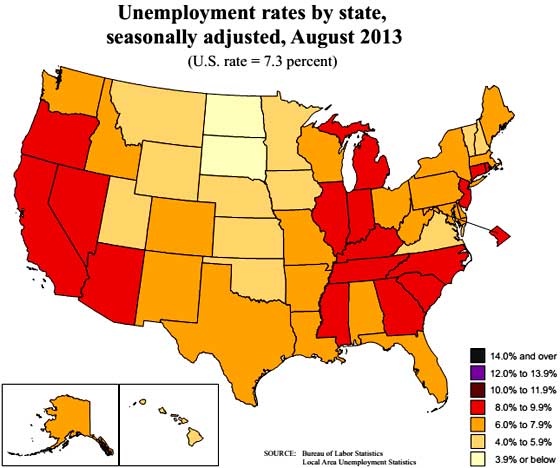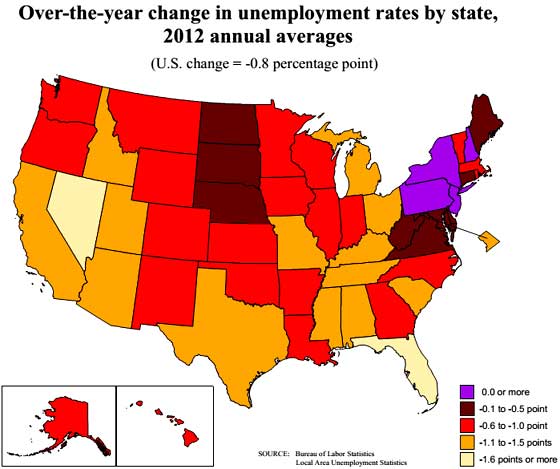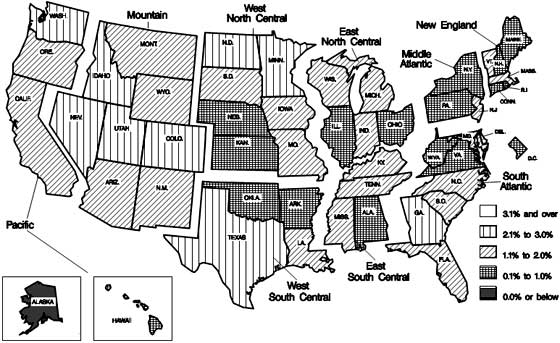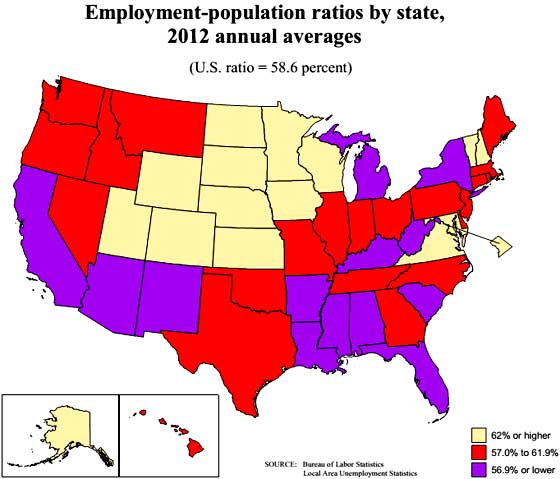The August state employment statistics show once again when breaking down unemployment and employment by states, there is little change. In spite of the national unemployment rate decline, 18 states plus D.C. showed their unemployment rate increased. Seventeen states had monthly unemployment rate declines and 15 of the states had no change at all. Below is the BLS map of state's unemployment rates for the month.

Nationally, the unemployment rate was 7.3% for August. There are four states with unemployment rates above 9%. Congratulations Nevada, you're #1 with a 9.5% unemployment rate. Illinois is not far behind with a 9.2% unemployment rate, Rhode Island, comes in at 9.1% and Michigan, 9.0%. California has a 8.9% unemployment rate. D.C., North Carolina and Georgia all have 8.7% unemployment rates. Tennessee and New Jersey, 8.5%, with Kentucky at 8.4%. The states with the lowest unemployment rates are North Dakota at 3.0% and South Dakota with a 3.8% unemployment rate.
The unemployment change from a year ago nationally has declined by -0.8 percentage points. The biggest improvement has been in Florida, with a -1.6 percentage point change from August 2012. Nevada's unemployment rate declined by -1.5 percentage points as has California. Florida and Rhode Island's unemployment rates both dropped by -1.3 percentage points as did West Virginia. All in all, 36 states plus D.C. showed an unemployment rate decline, 12 states increased and two had no change. Below is a map of the annual unemployment rate change, from 2012, only this map uses 2012 unemployment averages, versus the rates of 2012. Comparing the two maps should give a feel for which states have improved over the year.

The increase in unemployment rates isn't that much of a bad thing by itself since the national rate has dropped mainly because people are simply no longer counted as unemployed, not because they all found jobs. Still we see some of the most populous states having unemployment rates above or near 9% five years, eight months since the great recession started.
State monthly payrolls are a half and half. Payrolls increased in 29 states, decreased in 20 plus D.C. and had no change in Montana. By percentages of total payrolls, Nevada showed a 1.0% increase in jobs, Louisiana 0.7%. Nevada, is still one of the worst places in the country for jobs, as shown above. Connecticut and Georgia payrolls declined by -0.4% and Arizona along with D.C. dropped by -0.3%.
For the year, everyone gained jobs except for Alaska, whose payrolls dropped by -0.5% for the year. North Dakota, our one state booming economy, showed a 3.0% annual payrolls gain, Idaho, 2.8% and Utah increased payrolls by 2.6%. Below is the BLS map of payrolls annual change, based on percentages. Sixteen states, plus the District of Columbia showed annual payroll growth of 1% or less. Nine states showed payroll growth between 2.1% and 3.0%. 24 states between 1.1% and 2.0%. This is such a sad showing for an entire year of payroll growth for most of the country.

Another statistic available is the civilian, non-institutionalized population to those actually employed ratios per state. Below is the BLS map for the annual 2012 population to employment ratios and August's rates are here. Overall, those rates haven't changed much from the 2011 averages. One can see except really low ratios and the states in beige are the only ones with more normal percentages. What this implies is beyond the potential large populations of those in retirement, there are clearly large populations not being counted as part of the labor force who are capable of being so. When one sees a low population to employment ratio along with a high unemployment rate, most likely this implies people are not being counted as unemployed.

Generally speaking from the above maps, some states are way worse on employing their residents than others and some of this is demographics, beyond the types of industry and employers resident in a particular state. In other words, folks living in California, Nevada, Illinois and Rhode Island are still in a heap of hurt world. Yet states like North Dakota and Idaho and Utah are doing well in comparison. Overall the state breakdown shows how little jobs have moved for most.
All above maps were created by the BLS.

Recent comments